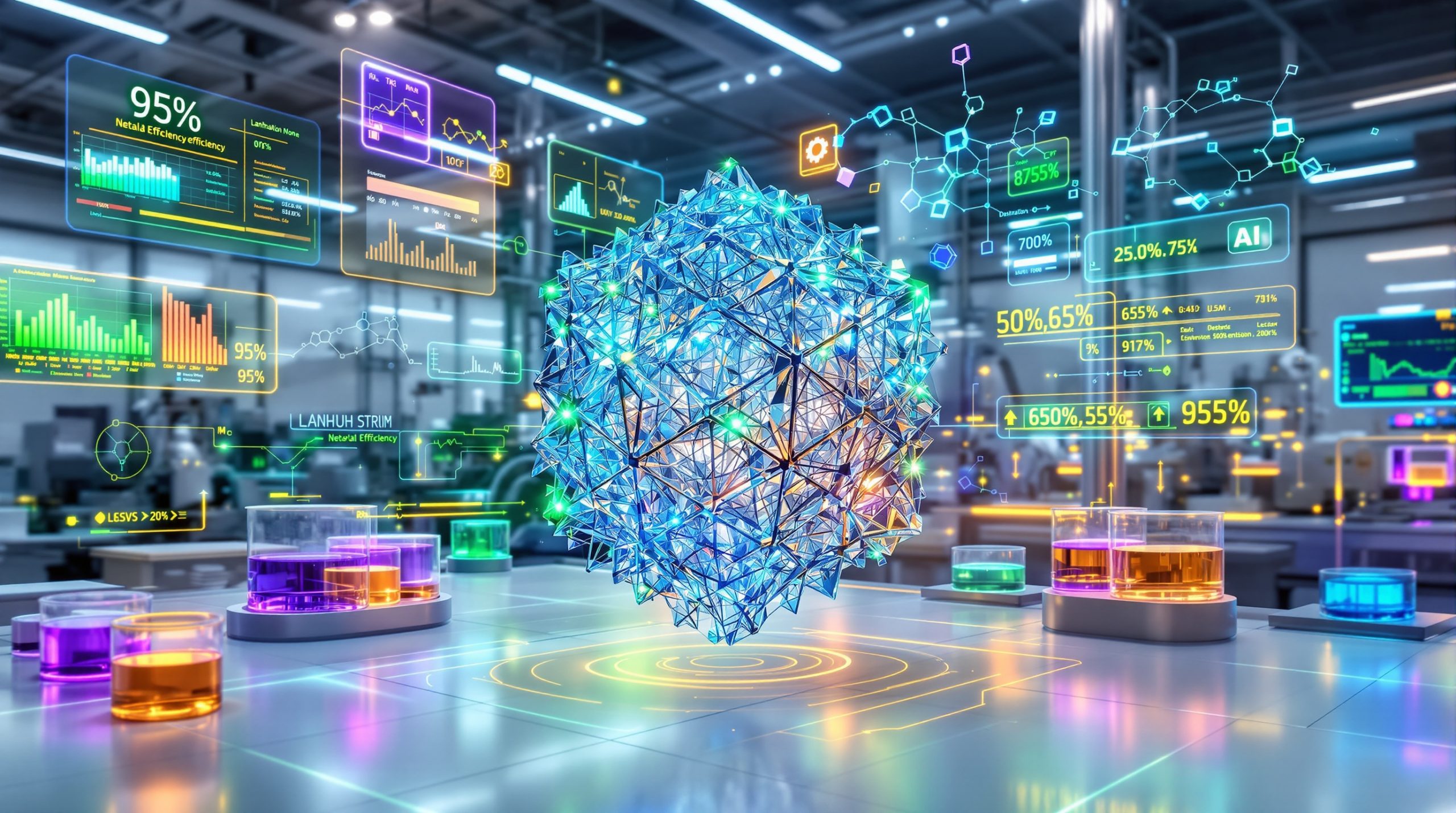What is Direct Lithium Extraction (DLE) Technology?
Direct Lithium Extraction (DLE) represents a revolutionary approach to lithium production that bypasses traditional methods like hard rock mining and evaporation ponds. This technology selectively extracts lithium from brine solutions using specialized sorbents, ion exchange resins, or membrane systems. Unlike conventional evaporation processes that can take 18-24 months, DLE can extract lithium in hours or days, dramatically accelerating production timelines while potentially reducing environmental impacts.
As Rio Tinto CEO Jakob Stausholm noted after their acquisition of Arcadium Lithium, "We're not experimenting – we're scaling proven technology." This statement highlights the growing confidence in DLE's viability despite being relatively new outside of China.
Understanding the DLE Innovation
DLE technologies work by selectively capturing lithium ions from brine while leaving other elements behind. This selectivity is achieved through chemical processes that can significantly reduce processing time compared to traditional methods. While several approaches exist, most involve pumping brine through specialized materials that capture only lithium, allowing for more efficient extraction.
The innovation lies not just in speed but in efficiency – some DLE methods can recover up to 90% of lithium present in brines compared to just 40-50% with conventional evaporation ponds. This dramatic improvement could fundamentally alter the economics of lithium production.
How DLE Differs from Traditional Extraction Methods
Traditional lithium extraction relies on either hard rock mining of spodumene or solar evaporation of brine in large ponds. Hard rock mining involves energy-intensive crushing, roasting, and chemical processing, while brine evaporation requires extensive land use and consumes significant water resources. DLE technologies aim to minimize these drawbacks by:
- Reducing water consumption by up to 70% compared to evaporation ponds
- Decreasing land footprint requirements by 90%
- Accelerating production from months/years to days/hours
- Enabling lithium recovery from previously uneconomical resources
- Potentially producing higher purity lithium compounds
Chinese companies including Jintai Lithium, Lanke Lithium, and Zangge Lithium have already demonstrated DLE at commercial scale, proving the technology's viability beyond pilot projects. However, adaptation to different brine chemistries remains a key challenge, as each deposit presents unique impurity profiles requiring tailored solutions.
Why is the Lithium Triangle Critical to Global Supply?
The Lithium Triangle—spanning across Argentina, Bolivia, and Chile—contains approximately 58% of the world's known lithium resources, making it the most concentrated lithium region on the planet. This South American region has become the focal point for direct lithium extraction and lithium triangle development as global demand for battery materials continues to grow exponentially.
The abundance of lithium-rich brines in this region has attracted major mining companies including Rio Tinto, which has committed $2.5 billion to expand its Rincon project in Argentina and $425 million toward the Salares Altoandinos project in Chile in partnership with state-owned ENAMI.
Geographical Significance of the Lithium Triangle
The Lithium Triangle's unique geology features vast salt flats (salares) with lithium-rich brines beneath them. The high-altitude Andean plateau provides ideal conditions for traditional evaporation methods due to intense solar radiation and low precipitation, though these same areas are now becoming testbeds for DLE implementation.
What makes this region particularly valuable is the concentration and quality of lithium resources found in relatively accessible brine formations. The lithium content in these brines is generally higher than in other global locations, making extraction potentially more economical despite technological challenges.
Resource Distribution Across Argentina, Bolivia, and Chile
Each country within the Lithium Triangle offers distinct advantages and challenges:
| Country | Estimated Resources | Key Production Areas | Current Production Status |
|---|---|---|---|
| Argentina | 19.3 million tonnes | Salar de Hombre Muerto, Salar de Olaroz, Salar del Rincón | Active production with significant foreign investment |
| Bolivia | 21 million tonnes | Salar de Uyuni | Limited production, state-controlled development |
| Chile | 9.6 million tonnes | Salar de Atacama | World's second-largest producer, mature operations |
Argentina has emerged as the most open to foreign investment, attracting over $4.2 billion between 2021-2025. Chile maintains stricter state controls through its state-owned companies, while Bolivia has kept most development under government oversight, limiting foreign participation.
The development disparity between these countries highlights how policy and regulatory frameworks significantly impact resource utilization, even when geological potential is similar. According to a detailed analysis of the region, political stability and investment frameworks play crucial roles in development pace.
How is Rio Tinto Positioning in the DLE Space?
Rio Tinto has executed a strategic pivot toward direct lithium extraction technology, making calculated moves to establish itself as a leader in this emerging field. The mining giant is betting that DLE will reshape the lithium production landscape, particularly in the Lithium Triangle.
Strategic Acquisitions and Investments
Rio Tinto has made several major investments to secure its position in the DLE space:
- The $6.7 billion acquisition of Arcadium Lithium in March 2025, gaining access to 28 years of DLE expertise
- Development of the Rincon project in Argentina's Salta province with a 3,000 tonnes per year starter plant completed in late 2024
- A planned $2.5 billion investment to expand Rincon's capacity to 60,000 tonnes annually
- Commitment of $425 million toward the Salares Altoandinos project in partnership with Chile's state-owned ENAMI
The Arcadium acquisition was particularly significant as it brought established DLE technology into Rio Tinto's portfolio. As CEO Jakob Stausholm explained, "We were new to DLE, so we built a starter plant… But when we acquired Arcadium Lithium, we gained access to 28 years of DLE experience. They invented it. We're not experimenting – we're scaling proven technology."
Rio Tinto's Shift from Hard Rock to DLE
Rio Tinto's strategic pivot away from spodumene mining toward DLE technology reflects a calculated assessment of market conditions and future cost competitiveness. With spodumene prices falling from their 2022 peak of $8,000-8,575 per tonne to just $600-620 per tonne by June 2025, the company appears to be positioning for a more economically sustainable approach to lithium production.
This shift included closing its Mount Cattlin spodumene mine and doubling down on brine-based projects. According to Stausholm, this decision was driven by a "deep belief about [future] cost curve" and a focus on producing battery-grade lithium refining that meets the stringent requirements of electric vehicle manufacturers.
The company's substantial investments during a period of depressed lithium prices indicate confidence in DLE's long-term economics despite current market volatility. Rio Tinto appears to be taking advantage of the down cycle to build capacity that will be positioned advantageously when prices recover.
What Challenges Does DLE Technology Face?
Despite its promise, DLE technology faces significant hurdles that have slowed widespread adoption outside of China. These challenges span technical, operational, and economic dimensions that collectively create uncertainty for potential investors and operators.
Technical and Operational Hurdles
DLE faces several implementation challenges:
- Varying effectiveness across different brine chemistries and impurity profiles
- Scaling from pilot plants to commercial production volumes
- Managing the disposal of waste streams and residual chemicals
- Optimizing energy consumption for economically viable operations
- Developing specialized equipment and materials for harsh brine environments
These technical challenges are evidenced by real-world examples like Eramet's Centenario project in Argentina, which produced only 440 tonnes of lithium carbonate in Q1 2025 due to delays in commissioning equipment. As one lithium consumer noted, "DLE is not always a 'safe bet' for production," highlighting the technology's current limitations.
The challenge of adapting DLE to different brine compositions is particularly significant, as each salar has unique chemical characteristics that can affect extraction efficiency and product purity. This requires customization of processes and materials, adding complexity to implementation.
Economic Viability in a Volatile Market
The economic case for DLE remains complex in the current market environment:
- High capital expenditure requirements for initial plant construction
- Lithium carbonate prices have plummeted from $80-82 per kg in November 2022 to $7.50-8.60 per kg by June 2025
- Technology risks may deter investment during periods of price weakness
- Competition from established, lower-cost conventional operations
- Uncertainty around long-term operational expenses at commercial scale
This 90% price decline has dramatically altered the economics of all lithium projects, putting pressure on companies to minimize costs. As one industry expert observed, "In the current lithium market downturn, [working] DLE or brine production is the more logical option on a purely cost basis, but that doesn't mean that it will be easy."
The timing of DLE's emergence during a period of depressed prices presents a paradox: while the technology may ultimately enable lower production costs, the investment required to reach commercial scale is harder to justify when prices are low, creating a chicken-and-egg problem for developers.
How Are Other Companies Implementing DLE Technology?
Beyond Rio Tinto, numerous companies are advancing DLE technology globally, with varying approaches and levels of success. Chinese firms have taken an early lead, while Western companies are pursuing both pure DLE and hybrid solutions.
Commercial DLE Projects Around the World
Several companies are making progress with DLE technology:
- Chinese Operations: Companies like Jintai Lithium, Lanke Lithium, and Zangge Lithium have achieved commercial-scale DLE production, establishing China as the early leader in operational experience
- Eramet: The French company's Centenario project in Argentina produced 440 tonnes of lithium carbonate in Q1 2025, though equipment commissioning delays affected output
- Lithium Argentina and Ganfeng Lithium: Planning a hybrid approach combining DLE with traditional evaporation at their Cauchari-Olaroz project, where a 5,000-tonne demonstration plant is under development
- Technology Providers: Numerous startups developing proprietary DLE solutions for licensing to resource owners
The technology landscape is being shaped by geopolitical factors as well. Reports indicate that China restricted exports of lithium processing technology in Q1 2025, creating what industry observers call a "technology gap" outside China. This restriction has accelerated domestic research and development efforts in Western countries.
Hybrid Approaches to Lithium Extraction
Many projects are adopting hybrid models that combine DLE with traditional methods:
- Pre-concentration of brines using solar evaporation before DLE processing
- Using DLE to increase recovery rates from partially evaporated brines
- Implementing DLE as a polishing step after conventional processing
- Combining hard rock and brine operations to diversify production methods
The Cauchari-Olaroz project exemplifies this hybrid approach, leveraging the strengths of both technologies. The pre-concentration through evaporation reduces the volume of brine that requires DLE processing, potentially lowering operational costs while still achieving higher recovery rates than evaporation alone.
Industry experts suggest these hybrid models may represent the most practical path forward in the near term, balancing the benefits of DLE with the established reliability of conventional methods during this transitional period for the industry.
What Impact Will DLE Have on Global Lithium Supply?
Direct Lithium Extraction has the potential to fundamentally reshape global lithium supply dynamics by unlocking resources that are currently uneconomical and accelerating production timelines. This could significantly alter the competitive landscape of the lithium industry.
Potential Production Growth and Timeline
DLE technology could significantly reshape global lithium supply dynamics:
- Accelerated project development timelines compared to traditional evaporation ponds
- Potential to unlock previously uneconomical lithium resources worldwide
- Reduced dependence on concentrated production regions
- More responsive supply adjustments to meet fluctuating demand
The technology could open up lithium production in regions previously considered unsuitable due to challenging brine chemistry or environmental constraints. This geographical diversification could reduce supply chain vulnerabilities and geopolitical risks associated with highly concentrated production.
Additionally, the shorter timeframe from investment to production—potentially reducing development cycles from 7+ years to 3-5 years—could make the lithium supply more responsive to market signals, potentially reducing the boom-bust cycles that have characterized the industry.
Environmental and Sustainability Implications
DLE offers several potential environmental advantages over conventional methods:
- Reduced freshwater consumption in water-stressed regions
- Smaller land footprint compared to evaporation ponds
- Lower carbon footprint potential through process optimization
- Possibility for remediation and reinjection of processed brines
- Reduced chemical usage compared to hard rock processing
These environmental benefits could become increasingly important as battery and EV manufacturers face growing pressure to demonstrate sustainable supply chains. Rio Tinto has explicitly positioned its DLE investments as producing "low-carbon lithium" that will appeal to environmentally conscious customers.
The water conservation aspect is particularly significant in the arid regions of the Lithium Triangle, where water usage has been a source of conflict with local communities. By reducing freshwater requirements and potentially allowing for brine reinjection, DLE could mitigate some of these social license challenges. This aligns with broader mining sustainability trends that are reshaping the industry.
How Is the Current Market Environment Affecting DLE Adoption?
The lithium market has experienced unprecedented volatility over the past three years, creating both opportunities and challenges for DLE technology adoption. Current market conditions are forcing companies to carefully evaluate the timing and scale of their investments.
Price Volatility and Investment Decisions
The lithium market's dramatic price swings have created a challenging environment for new technology adoption:
- Lithium carbonate prices have fallen by over 90% from their 2022 peak
- Low prices pressure margins for all producers, potentially limiting R&D investment
- Cautious capital allocation amid uncertain demand forecasts
- Preference for proven technologies in risk-averse investment climate
With lithium carbonate prices plummeting from $80-82 per kg in November 2022 to just $7.50-8.60 per kg by June 2025, the entire industry is under pressure to reduce costs. This price collapse has forced companies to prioritize near-term cash flow over long-term technology development in many cases.
However, as Rio Tinto's continued investment demonstrates, some major players view the current downturn as an opportunity to position for the next market upswing. Companies with strong balance sheets may be able to advance DLE projects while valuations and construction costs are lower, potentially gaining a competitive advantage when prices recover.
Geopolitical Factors Influencing Technology Transfer
The global race for lithium resources has political dimensions affecting DLE deployment:
- Reports of China restricting exports of lithium processing technology in Q1 2025
- Growing resource nationalism in lithium-producing countries
- Strategic partnerships forming between technology providers and resource owners
- Government incentives for domestic supply chain development in major markets
China's early lead in commercial DLE implementation has created a technology gap that Western companies are racing to close. The reported restrictions on technology exports have accelerated domestic development efforts in the US, Europe, and Australia.
At the same time, producing countries like Chile and Bolivia are increasingly assertive about capturing more value from their lithium resources. Chile's partnership with Rio Tinto through state-owned ENAMI represents a model where DLE technology is exchanged for access to resources, a trend that may become more common as countries seek to leverage their geological advantages.
What Does the Future Hold for Lithium Triangle Production?
The Lithium Triangle stands at a crossroads, with traditional production methods still dominating but DLE technology poised to potentially transform the region's output. The next five years could see significant changes in how these resources are developed.
Forecast Production Capacity Growth
The Lithium Triangle is positioned for significant expansion through both traditional and DLE methods:
- Argentina could increase production from approximately 37,500 tonnes LCE in 2024 to over 120,000 tonnes by 2028
- Chile's state-controlled expansion aims to grow from 140,000 tonnes to 200,000 tonnes LCE by 2030
- Bolivia's state-led initiatives target initial commercial production of 15,000 tonnes LCE by 2027
These projections reflect announced projects and expansions, with DLE technology playing an increasingly important role in new capacity. Rio Tinto's Rincon project alone could add 60,000 tonnes of annual capacity, while hybrid projects like Cauchari-Olaroz contribute to the growth outlook.
The realization of these forecasts depends heavily on market conditions, technology performance, and regulatory environments. The timeline for Bolivia's entry into significant commercial production remains particularly uncertain due to the country's cautious approach to foreign investment and technology partnerships.
Investment Trends and Market Outlook
Despite current price challenges, strategic investments continue in the region:
- Foreign direct investment in Argentina's lithium sector exceeded $4.2 billion between 2021-2025
- Joint ventures between technology providers and resource owners becoming more common
- Increasing vertical integration as battery and automotive manufacturers secure supply
- Growing emphasis on ESG credentials driving interest in more sustainable extraction methods
The investment landscape is
Want to Identify the Next Major Lithium Discovery?
Discover significant mineral finds on the ASX before the market moves with Discovery Alert's proprietary Discovery IQ model, which transforms complex DLE and lithium triangle announcements into actionable investment insights. Explore why major lithium discoveries can lead to exceptional returns by visiting Discovery Alert's dedicated discoveries page.




